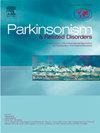Clinical and functional analysis of KIF5A related spastic paraplegia type 10
IF 3.4
3区 医学
Q2 CLINICAL NEUROLOGY
引用次数: 0
Abstract
Purpose
We aim to summarize the clinical and genetic features of five patients with KIF5A variants and explore genotype-phenotype correlations alongside a functional analysis of these mutations.
Methods
Detailed clinical data of five unrelated SPG10 patients were collected, including clinical symptoms, family history, physical examinations, brain and spinal MRI, electrophysiological examinations, etc. KIF5A variants were identified by whole exome sequencing, followed by Sanger sequencing, family co-segregation, and phenotypic reevaluation. Moreover, we also performed functional studies of each identified variant.
Results
All five probands were male, among whom one presented with pure form, and the other four with complicated form, including sensory ataxia, cognitive impairment, and peripheral neuropathy. Five heterozygous KIF5A mutations were identified, including c.446-2A > G, c.593T > C (p.Met198Thr), c.611G > A (p.Arg204Gln), c.614G > A (p.Ser205Asn), and c.838C > T (p.Arg280Cys). Among these, c.446-2A > G and c.614G > A (p.Ser205Asn) were newly reported. In vitro, c.446-2A > G destroyed the original donor site, leading to either 8bp deletion upstream of Exon6 (c.446_453del, p.V149Dfs∗20) or Exon 6 skipping (c.446_501del, p.V149Gfs∗4), thus generating two various truncated mutant forms with 167 and 151 amino acids, respectively. The two mutants had less molecular weight and reduced protein expression level, which also lost colocalization with α‐tubulin. Another four missense mutations, with normal mRNA and protein expression levels, lost colocalization with α‐tubulin in subcellular location.
Conclusion
We identified five KIF5A mutations with different phenotypes: the classic SPG symptoms with foot deformity, and complicated phenotype with sensory ataxia or peripheral neuropathy. Furthermore, we proved that KIF5A haploinsufficiency and abnormal subcellular location are associated with SPG10.
KIF5A相关痉挛性截瘫10型临床及功能分析
目的总结5例KIF5A变异患者的临床和遗传特征,探讨基因型-表型相关性以及这些突变的功能分析。方法收集5例无相关性SPG10患者的详细临床资料,包括临床症状、家族史、体格检查、脑脊髓MRI、电生理检查等。通过全外显子组测序鉴定KIF5A变异,随后进行Sanger测序、家族共分离和表型重评估。此外,我们还对每个鉴定的变异进行了功能研究。结果5例先证者均为男性,其中1例表现为单纯型,4例表现为感觉共济失调、认知障碍、周围神经病变等复杂型。共鉴定出5个KIF5A杂合突变,分别为C .446- 2a > G、C . 593t > C (p.Met198Thr)、C . 611g > A (p.Arg204Gln)、C . 614g > A (p.Ser205Asn)和C . 838c > T (p.Arg280Cys)。其中,c.446-2A >; G和c.614G > A (p.Ser205Asn)为新报道。体外,c.446-2A >; G破坏了原始供体位点,导致外显子6上游8bp的缺失(c.446_453del, p.V149Dfs∗20)或外显子6跳变(c.446_501del, p.V149Gfs∗4),从而产生两种不同的截断突变形式,分别含有167和151个氨基酸。这两个突变体分子量较小,蛋白表达水平降低,也失去了与α -微管蛋白的共定位。另外四个mRNA和蛋白表达水平正常的错义突变在亚细胞位置失去了与α -微管蛋白的共定位。结论我们发现了5种不同表型的KIF5A突变:典型SPG症状为足部畸形,复杂表型为感觉共济失调或周围神经病变。此外,我们证明了KIF5A单倍性不足和异常亚细胞定位与SPG10有关。
本文章由计算机程序翻译,如有差异,请以英文原文为准。
求助全文
约1分钟内获得全文
求助全文
来源期刊

Parkinsonism & related disorders
医学-临床神经学
CiteScore
6.20
自引率
4.90%
发文量
292
审稿时长
39 days
期刊介绍:
Parkinsonism & Related Disorders publishes the results of basic and clinical research contributing to the understanding, diagnosis and treatment of all neurodegenerative syndromes in which Parkinsonism, Essential Tremor or related movement disorders may be a feature. Regular features will include: Review Articles, Point of View articles, Full-length Articles, Short Communications, Case Reports and Letter to the Editor.
 求助内容:
求助内容: 应助结果提醒方式:
应助结果提醒方式:


